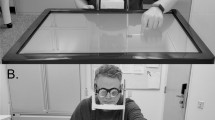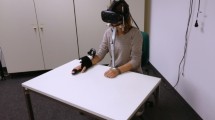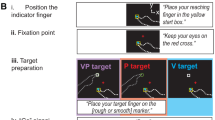Abstract
Timing is critical in determining the causal relationship between two events. Motor adaptation relies on the timing of actions and their results for determining which preceding control signals were responsible for subsequent error in the resulting movements. An artificially induced temporal delay in error feedback as short as 50 ms has been found to slow the learning rate of prism adaptation. Recent studies have demonstrated that our sense of simultaneity is flexibly adaptive when a persistent delay is inserted into visual feedback timing of one’s own action. Therefore, judgments of “subjective simultaneity” (i.e. whether two events are simultaneous on a subjective basis) do not necessarily correspond to the actual simultaneity of physical events. We evaluated the effects of adaptation to a temporal shift of subjective simultaneity on prism adaptation by examining whether prism adaptation depends on physical timing or subjective timing. We found that after persistently experiencing an additional 100-ms delay in a pointing experiment, psychometric curves of the timing of judgments about the temporal order of touching and visual feedback were shifted by 40 ms, indicating that subjective simultaneity adapted. Next, while maintaining temporal adaptation, participants adapted to spatial displacement caused by a prism with and without an additional temporal delay in feedback. Learning speed was reliably predicted by physical timing but not by subjective timing. These results indicate that prism adaptation occurs independently of awareness of subjective timing and may be processed in primary motor areas that are thought to have fidelity with temporal relations.






Similar content being viewed by others
References
Baddeley RJ, Ingram HA, Miall RC (2003) System identification applied to a visuomotor task: near-optimal human performance in a noisy changing task. J Neurosci 23:3066–3075
Bell CC, Han VZ, Sugawara Y, Grant K (1997) Synaptic plasticity in a cerebellum-like structure depends on temporal order. Nature 387:278–281
Boenke LT, Deliano M, Ohl FW (2009) Stimulus duration influences perceived simultaneity in audiovisual temporal-order judgment. Exp Brain Res 198:233–244
Brainard DH (1997) The psychophysics toolbox. Spat Vis 10:433–436
Celikel T, Szostak VA, Feldman DE (2004) Modulation of spike timing by sensory deprivation during induction of cortical map plasticity. Nat Neurosci 7:534–541
Ceux T, Wagemans J, Rosas P, Montagne G, Buekers M (2006) Perceptual-motor adaptations in a synchronization task: the joint effects of frequency and motion coherence manipulations. Behav Brain Res 168:226–235
Chen C, Thompson RF (1995) Temporal specificity of long-term depression in parallel fiber–Purkinje synapses in rat cerebellar slice. Learn Mem 2:185–198
Cheng S, Sabes PN (2006) Modeling sensorimotor learning with linear dynamical systems. Neural Comput 18:760–793
Clower DM, Boussaoud D (2000) Selective use of perceptual recalibration versus visuomotor skill acquisition. J Neurophysiol 84:2703–2708
Clower DM, Hoffman JM, Votaw JR, Faber TL, Woods RP, Alexander GE (1996) Role of posterior parietal cortex in the recalibration of visually guided reaching. Nature 383:618–621
Cunningham DW, Billock VA, Tsou BH (2001) Sensorimotor adaptation to violations of temporal contiguity. Psychol Sci 12:532–535
Debanne D, Gahwiler BH, Thompson SM (1998) Long-term synaptic plasticity between pairs of individual CA3 pyramidal cells in rat hippocampal slice cultures. J Physiol Lond 507:237–247
Di Luca M, Machulla TK, Ernst MO (2009) Recalibration of multisensory simultaneity: cross-modal transfer coincides with a change in perceptual latency. J Vision 9:7 1–16
Eagleman DM, Holcombe AO (2002) Causality and the perception of time. Trends Cogn Sci 6:323–325
Fino E, Glowinski J, Venance L (2005) Bidirectional activity-dependent plasticity at corticostriatal synapses. J Neurosci 25:11279–11287
Froemke RC, Dan Y (2002) Spike-timing-dependent synaptic modification induced by natural spike trains. Nature 416:433–438
Fujisaki W, Shimojo S, Kashino M, Nishida S (2004) Recalibration of audiovisual simultaneity. Nat Neurosci 7:773–778
Hanson JV, Heron J, Whitaker D (2008) Recalibration of perceived time across sensory modalities. Exp Brain Res 185:347–352
Harrar V, Harris LR (2005) Simultaneity constancy: detecting events with touch and vision. Exp Brain Res 166:465–473
Harrar V, Harris LR (2008) The effect of exposure to asynchronous audio, visual, and tactile stimulus combinations on the perception of simultaneity. Exp Brain Res 186:517–524
Harris CS (1963) Adaptation to displaced vision: visual, motor, or proprioceptive change? Science 140:812–813
Hatada Y, Miall RC, Rossetti Y (2006) Long lasting aftereffect of a single prism adaptation: directionally biased shift in proprioception and late onset shift of internal egocentric reference frame. Exp Brain Res 174:189–198
Held R, Gottlieb N (1958) Technique for studying adaptation to disarranged hand-eye coordination. Percept Motor Skill 8:83–86
Heron J, Hanson JV, Whitaker D (2009) Effect before cause: supramodal recalibration of sensorimotor timing. PLoS One 4:e7681
Houk JC, Buckingham JT, Barto AG (1996) Models of the cerebellum and motor learning. Behav Brain Sci 19:368–383
Imamizu H, Miyauchi S, Tamada T, Sasaki Y, Takino R, Putz B, Yoshioka T, Kawato M (2000) Human cerebellar activity reflecting an acquired internal model of a new tool. Nature 403:192–195
Ivry RB, Spencer RM, Zelaznik HN, Diedrichsen J (2002) The cerebellum and event timing. In: Highstein TM, Thach WT (eds) Cerebellum: recent developments in cerebellar research. New York Academy of Sciences, New York, pp 302–317
Kagerer FA, Contreras-Vidal JL, Stelmach GE (1997) Adaptation to gradual as compared with sudden visuo-motor distortions. Exp Brain Res 115:557–561
Keetels M, Vroomen J (2008) Temporal recalibration to tactile-visual asynchronous stimuli. Neurosci Lett 430:130–134
Kennedy JS, Buehner MJ, Rushton SK (2009) Adaptation to sensory-motor temporal misalignment: instrumental or perceptual learning? Q J Exp Psychol 62:453–469
Kitazawa S, Yin PB (2002) Prism adaptation with delayed visual error signals in the monkey. Exp Brain Res 144:258–261
Kitazawa S, Kohno T, Uka T (1995) Effects of delayed visual information on the rate and amount of prism adaptation in the human. J Neurosci 15:7644–7652
Knudsen EI, Konishi M (1978) A neural map of auditory space in the owl. Science 200:795–797
Kurata K, Hoshi E (1999) Reacquisition deficits in prism adaptation after muscimol microinjection into the ventral premotor cortex of monkeys. J Neurophysiol 81:1927–1938
Lee BS (1950) Effects of delayed speech feedback. J Acoust Soc Am 22:824–826
Luaute J, Schwartz S, Rossetti Y, Spiridon M, Rode G, Boisson D, Vuilleumier P (2009) Dynamic changes in brain activity during prism adaptation. J Neurosci 29:169–178
Markram H, Lubke J, Frotscher M, Sakmann B (1997) Regulation of synaptic efficacy by coincidence of postsynaptic APs and EPSPs. Science 275:213–215
Marr D (1969) A theory of cerebellar cortex. J Physiol Lond 202:437–470
Mazzoni P, Krakauer JW (2006) An implicit plan overrides an explicit strategy during visuomotor adaptation. J Neurosci 26:3642–3645
McKee SP (1981) A local mechanism for differential velocity detection. Vision Res 21:491–500
Miall RC, Weir DJ, Stein JF (1985) Visuomotor tracking with delayed visual feedback. Neuroscience 16:511–520
Miall RC, Weir DJ, Wolpert DM, Stein JF (1993) Is the cerebellum a smith predictor. J Mot Behav 25:203–216
Michel C, Pisella L, Prablanc C, Rode G, Rossetti Y (2007) Enhancing visuomotor adaptation by reducing error signals: single-step (aware) versus multiple-step (unaware) exposure to wedge prisms. J Cogn Neurosci 19:341–350
Miyazaki M, Yamamoto S, Uchida S, Kitazawa S (2006) Bayesian calibration of simultaneity in tactile temporal order judgment. Nat Neurosci 9:875–877
Navarra J, Hartcher-O’Brien J, Piazza E, Spence C (2009) Adaptation to audiovisual asynchrony modulates the speeded detection of sound. Proc Natl Acad Sci USA 106:9169–9173
Norris SA, Greger BE, Martin TA, Thach WT (2001) Prism adaptation of reaching is dependent on the type of visual feedback of hand and target position. Brain Res 905:207–219
Pawlak V, Kerr JND (2008) Dopamine receptor activation is required for corticostriatal spike-timing-dependent plasticity. J Neurosci 28:2435–2446
Pelli DG (1997) The VideoToolbox software for visual psychophysics: transforming numbers into movies. Spat Vis 10:437–442
Pisella L, Michel C, Grea H, Tilikete C, Vighetto A, Rossetti Y (2004) Preserved prism adaptation in bilateral optic ataxia: strategic versus adaptive reaction to prisms. Exp Brain Res 156:399–408
Ramachandran VS, Anstis SM (1986) The perception of apparent motion. Sci Am 254:102–109
Rao SM, Harrington DL, Haaland KY, Bobholz JA, Cox RW, Binder JR (1997) Distributed neural systems underlying the timing of movements. J Neurosci 17:5528–5535
Redding GM, Wallace B (2001) Calibration and alignment are separable: evidence from prism adaptation. J Mot Behav 33:401–412
Redding GM, Wallace B (2003) First-trial adaptation to prism exposure. J Mot Behav 35:229–245
Redding GM, Rossetti Y, Wallace B (2005) Applications of prism adaptation: a tutorial in theory and method. Neurosci Biobehav Rev 29:431–444
Smith WM, McCrary JW, Smith KU (1960) Delayed visual feedback and behavior. Science 132:1013–1014
Stetson C, Cui X, Montague PR, Eagleman DM (2006) Motor-sensory recalibration leads to an illusory reversal of action and sensation. Neuron 51:651–659
Stratton GM (1896) Some preliminary experiments on vision without inversion of the retinal image. Psychol Rev 3:611–617
Takahashi T, Konishi M (1986) Selectivity for interaural time difference in the owls midbrain. J Neurosci 6:3413–3422
Taub E, Goldberg IA (1973) Prism adaptation—control of intermanual transfer by distribution of practice. Science 180:755–757
Vroomen J, Keetels M, de Gelder B, Bertelson P (2004) Recalibration of temporal order perception by exposure to audio-visual asynchrony. Brain Res Cogn Brain Res 22:32–35
Wang HX, Gerkin RC, Nauen DW, Bi GQ (2005) Coactivation and timing-dependent integration of synaptic potentiation and depression. Nat Neurosci 8:187–193
Watanabe S, Hoffman DA, Migliore M, Johnston D (2002) Dendritic K+ channels contribute to spike-timing dependent long-term potentiation in hippocampal pyramidal neurons. Proc Natl Acad Sci USA 99:8366–8371
Winter R, Harrar V, Gozdzik M, Harris LR (2008) The relative timing of active and passive touch. Brain Res 1242:54–58
Yao HS, Dan Y (2001) Stimulus timing-dependent plasticity in cortical processing of orientation. Neuron 32:315–323
Yin PB, Kitazawa S (2001) Long-lasting aftereffects of prism adaptation in the monkey. Exp Brain Res 141:250–253
Zampini M, Brown T, Shore DI, Maravita A, Roder B, Spence C (2005) Audiotactile temporal order judgments. Acta Psychol (Amst) 118:277–291
Acknowledgments
We thank John E. Jacobson for discussions on temporal perception, Kaoru Nakamoto for conducting a preliminary experiment, Yuka Furukawa for organizing the experiments, Terrence J. Sejnowski for reading an earlier version of the manuscript, and two anonymous reviewers for helpful comments. We also thank Yasuhiro Wada and Mitsuo Kawato for giving us a chance of beginning this study.
Author information
Authors and Affiliations
Corresponding author
Additional information
H. Tanaka and K. Homma authors contributed equally to this work.
Rights and permissions
About this article
Cite this article
Tanaka, H., Homma, K. & Imamizu, H. Physical delay but not subjective delay determines learning rate in prism adaptation. Exp Brain Res 208, 257–268 (2011). https://doi.org/10.1007/s00221-010-2476-z
Received:
Accepted:
Published:
Issue Date:
DOI: https://doi.org/10.1007/s00221-010-2476-z




